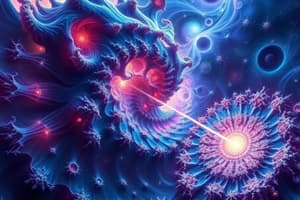Podcast
Questions and Answers
What is a defining characteristic of fractals?
What is a defining characteristic of fractals?
- They are simple shapes without self-similarity.
- They exist in integer dimensions.
- They always reveal complex patterns regardless of zoom level. (correct)
- They have only finite detail.
Which statement best describes Voronoi tessellations?
Which statement best describes Voronoi tessellations?
- Each region is defined by the nearest generating point. (correct)
- They are exclusively used for geometric modeling.
- They only pertain to mathematical theory, without practical applications.
- They create uniform cells of equal size.
How is the Fibonacci sequence related to spiral growth patterns?
How is the Fibonacci sequence related to spiral growth patterns?
- It explains how each number in the sequence relates to the golden ratio.
- It is a sequence that defines random arrangements in nature.
- It describes a direct relationship between plants and their nutrients.
- It often dictates the arrangement of leaves and flowers in nature. (correct)
What is a notable property of fractal dimensions?
What is a notable property of fractal dimensions?
In Voronoi tessellations, what is a Voronoi cell?
In Voronoi tessellations, what is a Voronoi cell?
Which of the following best describes the golden ratio as it pertains to spiral growth patterns?
Which of the following best describes the golden ratio as it pertains to spiral growth patterns?
Which application best illustrates the use of fractals?
Which application best illustrates the use of fractals?
What characterizes spiral growth patterns in biological systems?
What characterizes spiral growth patterns in biological systems?
Flashcards
Fractal Geometry
Fractal Geometry
Study of complex shapes showing self-similarity at different scales.
Voronoi Tessellation
Voronoi Tessellation
Plane divided into regions based on distance to points.
Self-Similarity
Self-Similarity
Shapes look same at different magnifications.
Voronoi Cell
Voronoi Cell
Signup and view all the flashcards
Fibonacci Sequence
Fibonacci Sequence
Signup and view all the flashcards
Golden Ratio
Golden Ratio
Signup and view all the flashcards
Spiral Growth
Spiral Growth
Signup and view all the flashcards
Mandelbrot Set
Mandelbrot Set
Signup and view all the flashcards
Study Notes
Fractal Geometry
- Definition: A branch of mathematics studying complex shapes that exhibit self-similarity at different scales.
- Key Properties:
- Self-Similarity: Shapes look similar regardless of the level of magnification.
- Infinite Detail: Fractals can reveal intricate patterns no matter how much they are zoomed in.
- Non-Integer Dimensions: Fractals often exist in fractal dimensions, which are not whole numbers.
- Examples:
- Mandelbrot Set: Defines complex structures that display infinite complexity.
- Julia Sets: Related to the Mandelbrot set; changes in parameters produce different patterns.
- Applications: Used in computer graphics, modeling natural phenomena (e.g., coastlines, clouds), and data compression.
Voronoi Tessellations
- Definition: A partitioning of a plane into regions based on distance to a specific set of points.
- Key Concepts:
- Voronoi Cell: Each region consists of all points closer to one generating point than to any other.
- Generators: The points (seeds) that dictate the boundaries of the cells.
- Properties:
- Cells can vary in size and shape based on point distribution.
- Useful for spatial analysis in geography, biology, and materials science.
- Applications: Used in urban planning, resource allocation, and modeling natural phenomena (e.g., animal territories).
Spiral Growth Patterns
- Definition: Natural arrangements that follow a spiral pattern, often based on mathematical ratios.
- Key Examples:
- Fibonacci Sequence: Each number is the sum of the two preceding ones; often seen in the arrangement of leaves, flower petals, and seed heads.
- Golden Ratio: Approximately 1.618; appears in spirals found in shells, hurricanes, and galaxies.
- Characteristics:
- Spirals can be found in different forms (e.g., logarithmic spirals and Archimedean spirals).
- They often maximize exposure to resources (light, nutrients) in plants.
- Applications: Observed in nature, art, architecture, and design, emphasizing aesthetic appeal and structural efficiency.
Fractal Geometry
- Fractals are complex shapes that exhibit self-similarity at different scales, with infinite detail and non-integer dimensions.
- Self-similarity allows fractals to look similar regardless of the level of magnification.
- The Mandelbrot Set is a classic example of a fractal, defining complex structures with infinite complexity.
- Julia Sets are related to the Mandelbrot set, with changes in parameters producing different patterns.
- Fractals have applications in computer graphics, modeling natural phenomena, and data compression.
Voronoi Tessellations
- Voronoi Tessellations are a partitioning of a plane into regions based on distance to a specific set of points.
- Each region, or Voronoi Cell, consists of all points closer to one generating point than to any other.
- The generators, or seeds, dictate the boundaries of the cells.
- Voronoi Tessellations have varying cell sizes and shapes based on point distribution.
- They are useful for spatial analysis in geography, biology, and materials science.
- Applications include urban planning, resource allocation, and modeling natural phenomena.
Spiral Growth Patterns
- Spiral growth patterns are natural arrangements that follow a spiral pattern, often based on mathematical ratios.
- The Fibonacci Sequence is a key example, where each number is the sum of the two preceding ones.
- The Golden Ratio, approximately 1.618, appears in spirals found in shells, hurricanes, and galaxies.
- Spirals can be found in different forms, including logarithmic spirals and Archimedean spirals.
- They often maximize exposure to resources, such as light and nutrients, in plants.
- Spiral growth patterns are observed in nature, art, architecture, and design, emphasizing aesthetic appeal and structural efficiency.
Studying That Suits You
Use AI to generate personalized quizzes and flashcards to suit your learning preferences.
Description
Explore the fascinating concepts of Fractal Geometry and Voronoi Tessellations. This quiz will cover critical properties, examples, and applications of fractals, as well as the fundamentals of Voronoi partitions. Dive into the world of mathematics where geometry reveals infinite detail and complex patterns.





